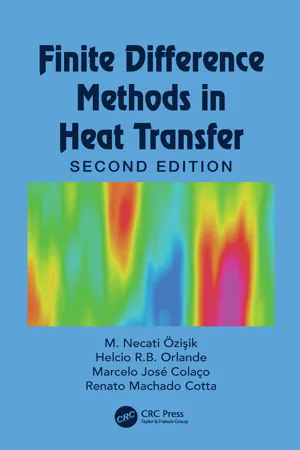
eBook - ePub
Finite Difference Methods in Heat Transfer
M. Necati Özişik, Helcio R. B. Orlande, Marcelo J. Colaço, Renato M. Cotta
This is a test
- 580 pages
- English
- ePUB (adapté aux mobiles)
- Disponible sur iOS et Android
eBook - ePub
Finite Difference Methods in Heat Transfer
M. Necati Özişik, Helcio R. B. Orlande, Marcelo J. Colaço, Renato M. Cotta
Détails du livre
Aperçu du livre
Table des matières
Citations
À propos de ce livre
Finite Difference Methods in Heat Transfer, Second Edition focuses on finite difference methods and their application to the solution of heat transfer problems. Such methods are based on the discretization of governing equations, initial and boundary conditions, which then replace a continuous partial differential problem by a system of algebraic equations. Finite difference methods are a versatile tool for scientists and for engineers. This updated book serves university students taking graduate-level coursework in heat transfer, as well as being an important reference for researchers and engineering.
Features
- Provides a self-contained approach in finite difference methods for students and professionals
- Covers the use of finite difference methods in convective, conductive, and radiative heat transfer
- Presents numerical solution techniques to elliptic, parabolic, and hyperbolic problems
- Includes hybrid analytical–numerical approaches
Foire aux questions
Comment puis-je résilier mon abonnement ?
Il vous suffit de vous rendre dans la section compte dans paramètres et de cliquer sur « Résilier l’abonnement ». C’est aussi simple que cela ! Une fois que vous aurez résilié votre abonnement, il restera actif pour le reste de la période pour laquelle vous avez payé. Découvrez-en plus ici.
Puis-je / comment puis-je télécharger des livres ?
Pour le moment, tous nos livres en format ePub adaptés aux mobiles peuvent être téléchargés via l’application. La plupart de nos PDF sont également disponibles en téléchargement et les autres seront téléchargeables très prochainement. Découvrez-en plus ici.
Quelle est la différence entre les formules tarifaires ?
Les deux abonnements vous donnent un accès complet à la bibliothèque et à toutes les fonctionnalités de Perlego. Les seules différences sont les tarifs ainsi que la période d’abonnement : avec l’abonnement annuel, vous économiserez environ 30 % par rapport à 12 mois d’abonnement mensuel.
Qu’est-ce que Perlego ?
Nous sommes un service d’abonnement à des ouvrages universitaires en ligne, où vous pouvez accéder à toute une bibliothèque pour un prix inférieur à celui d’un seul livre par mois. Avec plus d’un million de livres sur plus de 1 000 sujets, nous avons ce qu’il vous faut ! Découvrez-en plus ici.
Prenez-vous en charge la synthèse vocale ?
Recherchez le symbole Écouter sur votre prochain livre pour voir si vous pouvez l’écouter. L’outil Écouter lit le texte à haute voix pour vous, en surlignant le passage qui est en cours de lecture. Vous pouvez le mettre sur pause, l’accélérer ou le ralentir. Découvrez-en plus ici.
Est-ce que Finite Difference Methods in Heat Transfer est un PDF/ePUB en ligne ?
Oui, vous pouvez accéder à Finite Difference Methods in Heat Transfer par M. Necati Özişik, Helcio R. B. Orlande, Marcelo J. Colaço, Renato M. Cotta en format PDF et/ou ePUB ainsi qu’à d’autres livres populaires dans Sciences physiques et Énergie. Nous disposons de plus d’un million d’ouvrages à découvrir dans notre catalogue.
Informations
1
Basic Relations
Numerical methods are useful for solving fluid dynamics, heat and mass transfer problems, and other partial differential equations of mathematical physics when such problems cannot be handled by exact analysis techniques because of nonlinearities, complex geometries, and complicated boundary conditions. The development of high-speed digital computers significantly enhanced the use of numerical methods in various branches of science and engineering. Many complicated problems can now be solved at a very little cost and in a very short time with the available computing power.
Presently, the finite difference method (FDM), the finite volume method (FVM), and the finite-element method (FEM) are widely used for the solution of partial differential equations of heat, mass, and momentum transfer. Extensive amounts of literature exist on the application of these methods for the solution of such problems. Each method has its advantages depending on the nature of the physical problem to be solved, but there is no best method for all problems. For instance, the dimension of the problem is an important factor that deserves some consideration because an efficient method for one-dimensional problems may not be so efficient for two- or three-dimensional problems. FDMs are simple to formulate and can readily be extended to two- or three-dimensional problems. Furthermore, FDM is very easy to learn and apply for the solution of partial differential equations encountered in the modeling of engineering problems for simple geometries. For problems involving irregular geometries in the solution domain, the FEM is known for having more flexibility because the region near the boundary can readily be divided into subregions. A major drawback of FDM used to be its difficulty to handle effectively the solution of problems over arbitrarily-shaped complex geometries because of interpolation between the boundaries and the interior points, in order to develop finite difference expressions for nodes next to the boundaries. More recently, with the advent of numerical grid generation approaches, the FDM has become comparable to FEM in dealing with irregular geometries, while still maintaining the simplicity of the standard FDM.
In this book, we ...